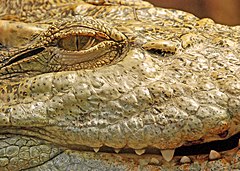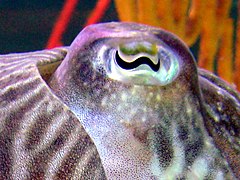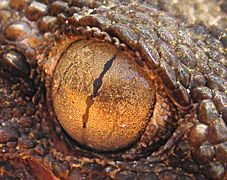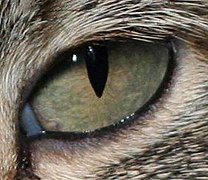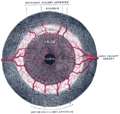Pupil: Difference between revisions
ClueBot NG (talk | contribs) m Reverting possible vandalism by 202.124.129.92 to version by Jusdafax. Report False Positive? Thanks, ClueBot NG. (2947706) (Bot) |
adding size of pupil |
||
| Line 43: | Line 43: | ||
Certain drugs cause constriction of the pupils, such as [[opioids]].<ref>{{Cite journal|last=Larson|first=Merlin D.|date=2008-06-01|title=Mechanism of opioid-induced pupillary effects|url=https://www.ncbi.nlm.nih.gov/pubmed/18397839|journal=Clinical Neurophysiology: Official Journal of the International Federation of Clinical Neurophysiology|volume=119|issue=6|pages=1358–1364|doi=10.1016/j.clinph.2008.01.106|issn=1388-2457|pmid=18397839}}</ref> Other drugs, such as [[atropine]], [[LSD]], [[MDMA]], [[mescaline]], [[psilocybin mushrooms]], [[cocaine]] and [[amphetamines]] may cause pupil dilation.{{citation needed|date=September 2014}} |
Certain drugs cause constriction of the pupils, such as [[opioids]].<ref>{{Cite journal|last=Larson|first=Merlin D.|date=2008-06-01|title=Mechanism of opioid-induced pupillary effects|url=https://www.ncbi.nlm.nih.gov/pubmed/18397839|journal=Clinical Neurophysiology: Official Journal of the International Federation of Clinical Neurophysiology|volume=119|issue=6|pages=1358–1364|doi=10.1016/j.clinph.2008.01.106|issn=1388-2457|pmid=18397839}}</ref> Other drugs, such as [[atropine]], [[LSD]], [[MDMA]], [[mescaline]], [[psilocybin mushrooms]], [[cocaine]] and [[amphetamines]] may cause pupil dilation.{{citation needed|date=September 2014}} |
||
Another term for the constriction of the pupil is [[miosis]]. Substances that cause miosis are described as miotic. Dilation of the pupil is [[mydriasis]]. Dilation can be caused by mydriatic substances such as an eye drop solution containing [[tropicamide]]. |
Another term for the constriction of the pupil is [[miosis]]. Substances that cause miosis are described as miotic. Dilation of the pupil is [[mydriasis]]. Dilation can be caused by mydriatic substances such as an eye drop solution containing [[tropicamide|tropiamide]]. |
||
== Size of pupil == |
|||
In 1964 an article by Eckhard H. Hess and James M. Polt is showed during solving simple multiplication problems size of pupil increase,<ref>{{Cite journal|last=Hess|first=Eckhard H.|last2=Polt|first2=James M.|date=1964-03-13|title=Pupil Size in Relation to Mental Activity during Simple Problem-Solving|url=http://science.sciencemag.org/content/143/3611/1190|journal=Science|language=en|volume=143|issue=3611|pages=1190–1192|doi=10.1126/science.143.3611.1190|issn=0036-8075|pmid=17833905}}</ref>like problem solving remembering also increase pupil size,<ref>{{Cite book|title=Psychophysiology: Human Behavior and Physiological Response (Psychophysiology: Human Behavior & Physiological Response); 5 edition|last=L. Andreassi|first=John|publisher=Psychology Press|year=2006|isbn=978-0805849516|location=|pages=}}</ref> however when brain required to process at a rate above their maximum capacity, the size of pupil decrease of baseline diameter.<ref>{{Cite web|url=https://prezi.com/e00bcswh1fhp/my-brain-is-overloaded/|title=My Brain is Overloaded|website=prezi.com|language=en|access-date=2017-02-28}}</ref> |
|||
==Other animals== |
==Other animals== |
||
Revision as of 01:32, 28 February 2017
| Pupil | |
|---|---|
 | |
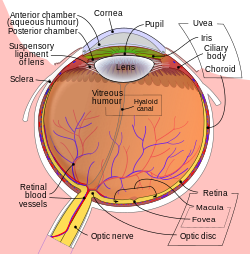 Schematic diagram of the human eye. | |
| Details | |
| Identifiers | |
| Latin | Pupilla (Plural: Pupillae) |
| MeSH | D011680 |
| TA98 | A15.2.03.028 |
| TA2 | 6754 |
| FMA | 58252 |
| Anatomical terminology | |
The pupil is a hole located in the centre of the iris of the eye that allows light to strike the retina.[1] It appears black because light rays entering the pupil are either absorbed by the tissues inside the eye directly, or absorbed after diffuse reflections within the eye that mostly miss exiting the narrow pupil.
In humans the pupil is round, but other species, such as some cats, have vertical slit pupils, goats have horizontally oriented pupils, and some catfish have annular types.[2] In optical terms, the anatomical pupil is the eye's aperture and the iris is the aperture stop. The image of the pupil as seen from outside the eye is the entrance pupil, which does not exactly correspond to the location and size of the physical pupil because it is magnified by the cornea. On the inner edge lies a prominent structure, the collarette, marking the junction of the embryonic pupillary membrane covering the embryonic pupil.
Controlling
The iris is a contractile structure, consisting mainly of smooth muscle, surrounding the pupil. Light enters the eye through the pupil, and the iris regulates the amount of light by controlling the size of the pupil. The iris contains two groups of smooth muscles; a circular group called the sphincter pupillae, and a radial group called the dilator pupillae. When the sphincter pupillae contract, the iris decreases or constricts the size of the pupil. The dilator pupillae, innervated by sympathetic nerves from the superior cervical ganglion, cause the pupil to dilate when they contract. These muscles are sometimes referred to as intrinsic eye muscles. The sensory pathway (rod or cone, bipolar, ganglion) is linked with its counterpart in the other eye by a partial crossover of each eye's fibers. This causes the effect in one eye to carry over to the other. If the drug pilocarpine is administered, the pupils will constrict and accommodation is increased due to the parasympathetic action on the circular muscle fibers, conversely, atropine will cause paralysis of accommodation (cycloplegia) and dilation of the pupil.
Optic effects
When bright light is shone on the eye, light sensitive cells in the retina, including rod and cone photoreceptors and melanopsin ganglion cells, will send signals to the oculomotor nerve, specifically the parasympathetic part coming from the Edinger-Westphal nucleus, which terminates on the circular iris sphincter muscle. When this muscle contracts, it reduces the size of the pupil. This is the pupillary light reflex, which is an important test of brainstem function. Furthermore, the pupil will dilate if a person sees an object of interest.
The pupil gets wider in the dark but narrower in light. When narrow, the diameter is 2 to 4 millimeters. In the dark it will be the same at first, but will approach the maximum distance for a wide pupil 3 to 8 mm. In any human age group there is however considerable variation in maximal pupil size. For example, at the peak age of 15, the dark-adapted pupil can vary from 4 mm to 9 mm with different individuals. After 25 years of age the average pupil size decreases, though not at a steady rate.[3][4] At this stage the pupils do not remain completely still, therefore may lead to oscillation, which may intensify and become known as hippus. The constriction of the pupil and near vision are closely tied. In bright light, the pupils constrict to prevent aberrations of light rays and thus attain their expected acuity; in the dark this is not necessary, so it is chiefly concerned with admitting sufficient light into the eye.[5]
A condition called bene dilitatism occurs when the optic nerves are partially damaged. This condition is typified by chronically widened pupils due to the decreased ability of the optic nerves to respond to light. In normal lighting, people afflicted with this condition normally have dilated pupils, and bright lighting can cause pain. At the other end of the spectrum, people with this condition have trouble seeing in darkness. It is necessary for these people to be especially careful when driving at night due to their inability to see objects in their full perspective. This condition is not otherwise dangerous.
Effect of drugs
The sphincter muscle has a parasympathetic innervation, and the dilator has a sympathetic innervation. In pupillary constriction induced by pilocarpine, not only is the sphincter nerve supply activated but that of the dilator is inhibited. The reverse is true, so control of pupil size is controlled by differences in contraction intensity of each muscle.
Certain drugs cause constriction of the pupils, such as opioids.[6] Other drugs, such as atropine, LSD, MDMA, mescaline, psilocybin mushrooms, cocaine and amphetamines may cause pupil dilation.[citation needed]
Another term for the constriction of the pupil is miosis. Substances that cause miosis are described as miotic. Dilation of the pupil is mydriasis. Dilation can be caused by mydriatic substances such as an eye drop solution containing tropiamide.
Size of pupil
In 1964 an article by Eckhard H. Hess and James M. Polt is showed during solving simple multiplication problems size of pupil increase,[7]like problem solving remembering also increase pupil size,[8] however when brain required to process at a rate above their maximum capacity, the size of pupil decrease of baseline diameter.[9]
Other animals
Not all animals have circular pupils. Some have slits or ovals which may be oriented vertically, as in crocodiles, vipers, cats and foxes, or horizontally as in some rays, flying frogs, mongooses and artiodactyls such as sheep, elk, red deer, reindeer and hippopotamus, as well as the domestic horse. Goats, toads and octopus pupils tend to be horizontal and rectangular with rounded corners. Some skates and rays have crescent shaped pupils,[10] gecko pupils range from circular, to a slit, to a series of pinholes, and the cuttlefish pupil is a smoothly curving W shape. There are rare cases of humans with very unusually shaped pupils, such as peanut-shaped pupils.
There may be differences in pupil shape even between closely related animals. In felids, there are differences between small- and large eyed species. The domestic cat (Felis sylvestris domesticus) has vertical slit pupils, its large relative the Siberian tiger (Panthera tigris altaica) has circular pupils and the Eurasian lynx (Lynx lynx) is intermediate between those of the domestic cat and the Siberian tiger. A similar difference between small and large species may be present in canines. The small European red fox (Vulpes vulpes) has vertical slit pupils whereas their large relatives, the gray wolf (Canis lupus lupus) and domestic dogs (Canis lupus familiaris) have round pupils.
One explanation for the evolution of slit pupils is that they can exclude light more effectively than a circular pupil. This would explain why slit pupils tend to be found in the eyes of animals with a crepuscular or nocturnal lifestyle that need to protect their eyes during daylight. Constriction of a circular pupil (by a ring-shaped muscle) is less complete than closure of a slit pupil, which uses two additional muscles that laterally compress the pupil.[11] For example, the cat's slit pupil can change the light intensity on the retina 135-fold compared to 10-fold in humans.[12] However, this explanation does not account for circular pupils that can be closed to a very small size (e.g., 0.5 mm in the tarsier) and the rectangular pupils of many ungulates which do not close to a narrow slit in bright light.[13] An alternative explanation is that a partially constricted circular pupil shades the peripheral zones of the lens which would lead to poorly focused images at relevant wavelengths. The vertical slit pupil allows for use of all wavelengths across the full diameter of the lens, even in bright light.[2] It has also been suggested that in ambush predators such as some snakes, vertical slit pupils may aid in camouflage, breaking up the circular outline of the eye.[14]
In a study of Australian snakes, pupil shapes correlated both with diel activity times and with foraging behaviour. Most snake species with vertical pupils were nocturnal and also ambush foragers, and most snakes with circular pupils were diurnal and active foragers. Overall, foraging behaviour predicted pupil shape accurately in more cases than did diel time of activity, because many active-foraging snakes with circular pupils were not diurnal. It has been suggested that there may be a similar link between foraging behaviour and pupil shape amongst the felidae and canidae discussed above.[14]
- Animals with non-circular pupils
-
A goat with horizontal rectangular pupils
-
A stingray with crescent pupils
-
A crocodile with vertical slit pupils
-
A cuttlefish with W-shaped pupils
-
A gecko with 'string of pearls' pupils
-
A cat with vertical slit pupils
See also
- Pupillary response
- Pupil function
- Dilated fundus examination
- Eye contact
- Horner's syndrome
- Mydriasis
- Synechia (eye)
- Anisocoria
- Adie's pupil
- Argyll Robertson pupil
- Light-near dissociation
- Marcus Gunn Pupil
Additional images
-
Iris, front view.
-
Iris dilated for retina examination.
-
Optic effect: Macrophotography of a pupil (which gets wider in the dark amid photo flash).
References
- ^ Cassin, B. and Solomon, S. (1990) Dictionary of Eye Terminology. Gainesville, Florida: Triad Publishing Company.
- ^ a b Malmström T, Kröger RH (January 2006). "Pupil shapes and lens optics in the eyes of terrestrial vertebrates". J. Exp. Biol. 209 (Pt 1): 18–25. doi:10.1242/jeb.01959. PMID 16354774.
- ^ "Aging Eyes and Pupil Size". Amateurastronomy.org. Retrieved 2013-08-28.
- ^ "Factors Affecting Light-Adapted Pupil Size in Normal Human Subjects" (PDF). Retrieved 2013-08-28.
- ^ "Sensory Reception: Human Vision: Structure and Function of the Eye" Encyclopædia Brtiannicam Chicago, 1987
- ^ Larson, Merlin D. (2008-06-01). "Mechanism of opioid-induced pupillary effects". Clinical Neurophysiology: Official Journal of the International Federation of Clinical Neurophysiology. 119 (6): 1358–1364. doi:10.1016/j.clinph.2008.01.106. ISSN 1388-2457. PMID 18397839.
- ^ Hess, Eckhard H.; Polt, James M. (1964-03-13). "Pupil Size in Relation to Mental Activity during Simple Problem-Solving". Science. 143 (3611): 1190–1192. doi:10.1126/science.143.3611.1190. ISSN 0036-8075. PMID 17833905.
- ^ L. Andreassi, John (2006). Psychophysiology: Human Behavior and Physiological Response (Psychophysiology: Human Behavior & Physiological Response); 5 edition. Psychology Press. ISBN 978-0805849516.
- ^ "My Brain is Overloaded". prezi.com. Retrieved 2017-02-28.
- ^ Murphy, C.J.; Howland, H.C. (1990). "The functional significance of crescent-shaped pupils and multiple pupillary apertures". Journal of Experimental Zoology. 256: 22. doi:10.1002/jez.1402560505.
{{cite journal}}: Unknown parameter|lastauthoramp=ignored (|name-list-style=suggested) (help) - ^ Walls, G.L., (1942). The Vertebrate Eye and its Adaptive Radiation. The Cranbrook Institute of Science, Bloomington Hills, Michigan.
- ^ Hughes, A. (1977). "The topography of vision in mammals of contrasting life style: comparative optics and retinal organisation", pp. 613–756 in F. Crescitelli (Ed.), Handbook of Sensory Physiology VII/5., Springer-Verlag, Berlin.
- ^ Land, M.F. (2006). "Visual optics: the shapes of pupils". Current Biology. 16 (5): R167–8. doi:10.1016/j.cub.2006.02.046. PMID 16527734.
- ^ a b Brischoux, F., Pizzatto, L. and Shine, R. (2010). "Insights into the adaptive significance of vertical pupil shape in snakes". Journal of Evolutionary Biology. 23 (9): 1878–85. doi:10.1111/j.1420-9101.2010.02046.x. PMID 20629855.
{{cite journal}}: CS1 maint: multiple names: authors list (link)
External links
- Atlas image: eye_1 at the University of Michigan Health System — "Sagittal Section Through the Eyeball"
- Atlas image: eye_2 at the University of Michigan Health System — "Sagittal Section Through the Eyeball"
- A pupil examination simulator, demonstrating the changes in pupil reactions for various nerve lesions.



